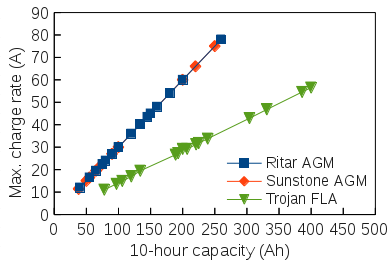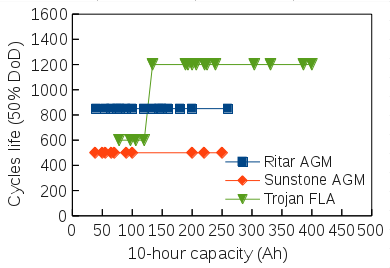Many times I have read that Absorbed Glass Mat (AGM) lead-acid batteries are ‘better’ than traditional wet (flooded) lead-acid batteries. This article examines the characteristics and performance of the AGM and wet batteries. The ‘best’ choice depends on the budget and the application. AGM’s are sealed and can charge three times faster. Wet deep-cycle batteries cost less and can last 1.4 times last longer. Where either technology is safe, most users would not notice the performance differences between wet and AGM batteries and cost-savings can be substantial.
Products compared
I downloaded products specifications for Ritar DC series AGM (China), SunStone ML series AGM (China) and Trojan Signature Line wet deep-cycle batteries (U.S.A.).
I compared ratings at 12 V. Many of the Trojan batteries evaluated were 6 V and I then considered two 6 V in series. For two batteries in series the mass and voltage are doubled and the capacity (Ah) is unchanged. And for two batteries in parallel, the mass and capacity are doubled and the voltage is unchanged.
Capacity versus mass
More lead = more capacity, as the following graph shows. The linear regression fitted to the entire dataset can be used to predict mass and identify fraudulent ratings. A battery that plots below the trend (actual mass less than predicted) is over-rated.

Mass versus 10-hour capacity for Ritar DC series AGM, SunStone ML series AGM and Trojan Signature Line flooded lead-acid batteries. Linear model fitted to all data points.
Charging rate versus capacity
More lead = higher acceptance = faster charging. For the two AGMs evaluated, maximum charging rate is 0.30 times 10-hour capacity. For the wet batteries, maximum charging rate is 0.14 times the 10-hour capacity (Trojan actually specifies 0.10 to 0.13 times the 20-hour capacity).

Maximum charging rates for Ritar DC series AGM, SunStone ML series AGM and Trojan Signature Line flooded lead-acid batteries. Maximum charging rates are commonly summarised as a fraction of capacity (= the gradient of the rate-capacity line).
A second consideration is charging efficiency, because not all of the input current is stored. Some of the energy is lost to heat and gassing. Charging efficiency for AGM batteries is about 95% and greater than 85% for wet batteries. Multiplying charging rates by efficiency increases the differences between AGM and wet batteries. For the two AGMs evaluated, the effective maximum charging rate is 0.29 times 10-hour capacity versus 0.12 times for the wet batteries.
These results agree fairly well with my own testing. My Trojan T105s bulk-charge at about 0.13 times 10-hour capacity. My old Ritar DC12-100 charges at about 0.24 times 10-hour capacity.
Note that maximum charging rates vary between manufacturers, depending on the design, construction and safety margins. For Trojan AGMs (not included in this study), maximum charging rate is about 0.2 times 20-hour capacity.
Cycle life
Cycle life determines lifetime cost. AGM batteries are sealed, maintenance free and tend to have shorter cycle lives than wet deep-cycle batteries, as the following graph shows. The larger Trojan Signature Line batteries are exceptionally rugged and can deliver 50% of rated capacity after 1200 cycles. Next, the Ritar DC series are true deep-cycle AGM batteries and can deliver 60% of rated capacity after 850 cycles. Last, the SunStone ML series are really for standby use and can deliver 60% of their rated capacity after 500 cycles.

Cycles to 60% of rated-capacity for Ritar DC series AGM and SunStone ML series AGM batteries and 50% of rated-capacity for Trojan Signature Line flooded lead-acid batteries. Average depth of discharge was 50% for all three manufacturers. Observe that cycle life is unrelated to capacity, except for the smaller Trojans, which must differ in design and construction to the higher-capacity models.
Be careful when comparing cycle life ratings that the depth of discharge and the percentage reduction in final capacity are the same. Increasing depth of discharge will reduce battery life. Increasing the capacity end-point will reduce battery life (e.g. the Trojan cycle life ratings would be a little bit lower at 60% of rated capacity, rather than 50% as specified).
Summary
I have experience with both Ritar DC series AGM and Trojan Signature Line wet deep-cycle batteries. The following table summarises what I think are the important differences between these two battery technologies.
| Main pros and cons of AGM and wet deep-cycle batteries. | ||||||||||
|
Two Trojan T105s are doing a good job in my dual-battery plus solar system:
- Excellent value for money (low cost, high capacity, long life).
- Slower charging is no issue because Australia is a big country and I drive long distances when travelling which allows the batteries plenty of time to charge. When camped, the charging rate is limited by my solar panels, which can deliver a maximum of 12 A.
- Maintaining the T105s is not a great inconvenience. They don’t use much water.
AGMs are required where there are safety concerns or unusual operating conditions:
- Inside vehicle, where gases can’t be vented.
- Marine applications (salt water + battery acid = Chlorine gas).
- Short drives, where the batteries have to charge quickly.
- Serious off-road driving, where wet batteries can spill (my Trojans spilled some acid at Cape York, Queensland).
Nice comparison! Both batteries have their own advantages, however I would definitely choose for AGM batteries. They may cost a bit more but the benefits outweigh these extra costs.
“They may cost a bit more but the benefits outweigh these extra costs” is an unsupported statement that one might commonly hear from a battery salesperson. While there are technical and safety advantages to AGM, flooded deep cycle batteries are a proven technology.
You can buy longlife agm from sunstone (OPG series) with a cycle life of 3600 times to 50% discharge , and 6000 cycles at 20% – that’s over 15 years ! . The weight may be an issue for some with 6 x 2v cells of 18.5kg each for just 200 amp hours.@ 12 volts.There are short , medium and long life battery types .You get what you pay for,and the weight often reflects the lifespan of a battery. I advise consumers calculate the actual cost of battery wear per cycle to say 50% discharge to compare battery types – as well as maintenance and gassing ventilation requirements .Some importers on ebay are bringing in container loads of these long life AGM batteries at half the price the local retailers sell them for , so expect prices to keep dropping